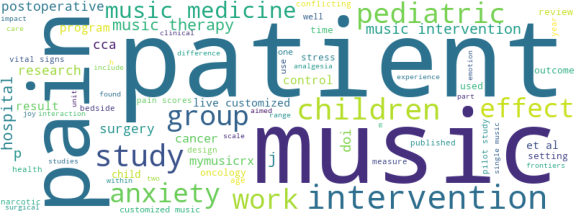| Id | 770 | |
| Author | Perkins R.S., Boyce M., Byrtek M.C., Ellis R.C., Hill C., Fitzpatrick P.S., Demirel S. | |
| Title | Roadmap to wellness: Exploring live customized music at the bedside for hospitalized children | |
| Reference | Perkins R.S., Boyce M., Byrtek M.C., Ellis R.C., Hill C., Fitzpatrick P.S., Demirel S.; Roadmap to wellness: Exploring live customized music at the bedside for hospitalized children ;Frontiers in Oncology vol:8.0 issue: FEB page: |
|
| Link to article | https://www.scopus.com/inward/record.uri?eid=2-s2.0-85042107067&doi=10.3389%2ffonc.2018.00021&partnerID=40&md5=5bfa2e2570b1910b2d5671ca0ea31373 |
|
| Abstract | Background: Randomized trials on clinical outcomes of music are conflicting, with few performed in the postoperative pediatric population. We aimed to determine if there was a benefit of a live, customized bedside music delivery program (MyMusicRx®) for children hospitalized after pediatric surgery. We present our perspective on the utility of music medicine, review others work in this area, and discuss future directions. Methods: All admitted postsurgical patients aged between 5 and 18 years were considered. One live, customized music session was delivered by a MyMusicRx® music specialist to intervention participants, and compared with matched controls who did not receive music intervention. Pain, cumulative analgesia dosage, and vital signs within 12 h after unit arrival were compared between groups. Results: Thirty-two participants (16 intervention, 16 controls; 8:8 females:males per group) were enrolled. No differences in age, surgery length, or duration of music intervention were found between groups. No differences in pain scores (p = 0.73), heart rate (p = 0.82), respirations (p = 84), narcotic (p = 0.92) or non-narcotic medication usage (p = 0.88, 0.86, 0.95; ibuprofen, acetaminophen, and ketorolac, respectively), or time to first narcotic dose (p = 0.64) were found. Conclusion: A single music intervention in the acute postoperative period did not appear to be adequate to augment traditional methods of pain and hemodynamic control. Prior studies have similar outcome measures but conflicting results. We did not evaluate psychological well-being, patient engagement, or family perception in this pilot study. Future directions include developing and validating a tool that explores the observable impact of music medicine on childrens emotions and behaviors. © 2018 Perkins, Boyce, Byrtek, Ellis, Hill, Fitzpatrick and Demirel. |
|
| Keywords | Customized; Joy; Live; Music; Neuropsychology; Pediatrics; Postoperative; Transformative |
Wordcloud:



